No way forward
WPR10FA234
 By David Jack Kenny
By David Jack Kenny
People find out the hard way that bad things can happen fast while trying to squeeze an airplane between descending ceilings and rising terrain. There are hints that pilots who fly the same route frequently are particularly susceptible to trying to shave those margins.
About 10:30 a.m. on May 9, 2010, the left wing of a Piper PA28-235 clipped a tree on a hillside northeast of the Livermore, Calif., Municipal Airport. The wing came apart as the fuselage continued southeastward, eventually hitting the ground 110 yards away. Fragments of the airplane tumbled for another 180 yards before coming to rest. The 75-year-old pilot and her 77-year-old husband were both killed.
The couple were returning from Auburn to their home base in San Carlos, a distance of more than 100 nautical miles. It was a route they had flown often over the years in order to visit family. Auburn lies at the western edge of the Sierra Nevada’s foothills at 1,539 feet msl, while San Carlos is on the southeastern shore of the San Francisco Bay at a surveyed elevation of five feet. The terrain between them is largely flat—except for a couple of ranges of low hills on the eastern side of the bay. While individual peaks reach as high as 3,850 feet, most of the ridges top out at about 2,300 feet msl.
Related Links
The Dakota departed Auburn under VFR at about 9:45 a.m. The pilot requested and received flight following from the Northern California Tracon, which authorized altitudes at the pilot’s discretion. A reconstruction of the couple’s radar track showed a steady southwesterly course at 3,000 feet until they neared the hills, at which point they turned south-southeast and descended to 2,600 feet. The last radar contact came at 2,799 feet msl about 10 miles southeast of the direct route to San Carlos. The elevation of the accident site was 2,412 feet msl, and the airplane struck the trees less than 50 feet above the ground. The pilot never made a distress call or requested any assistance from ATC.
She had not obtained a formal weather briefing, though a relative told investigators that she had checked conditions at San Carlos before leaving. A weather briefing would have been a good idea. While San Carlos was technically VFR, a trough over Northern California had brought in a moist westerly flow. The 2,800-foot broken layer at their destination wasn’t much higher than the hills they had to cross, and in those hills the ceilings were lower still. A witness who heard the airplane pass was unable to see it through the fog; she thought it sounded “lower than most that fly in that area.” A moment later she heard the impact.
The pilot had almost a thousand hours of flight time, but no instrument rating. Her husband was also a private pilot with a valid medical, but according to relatives he no longer flew as pilot in command. Between them they’d had ample opportunity to learn the dangers of scud-running, and perhaps to grow uncomfortable with the diminishing visibility up ahead. Did their familiarity with the route or the fact that they were now so close to home prompt them to press on? After less than an hour aloft, it seems sure that they had enough fuel to divert back to an airport east of the hills, especially since several were closer to the accident site than it was to their destination.
Family members told investigators that the couple had wanted to get home in time for an afternoon meeting. But meetings can be postponed, while the weather that must be dealt with is the weather that’s out there now.